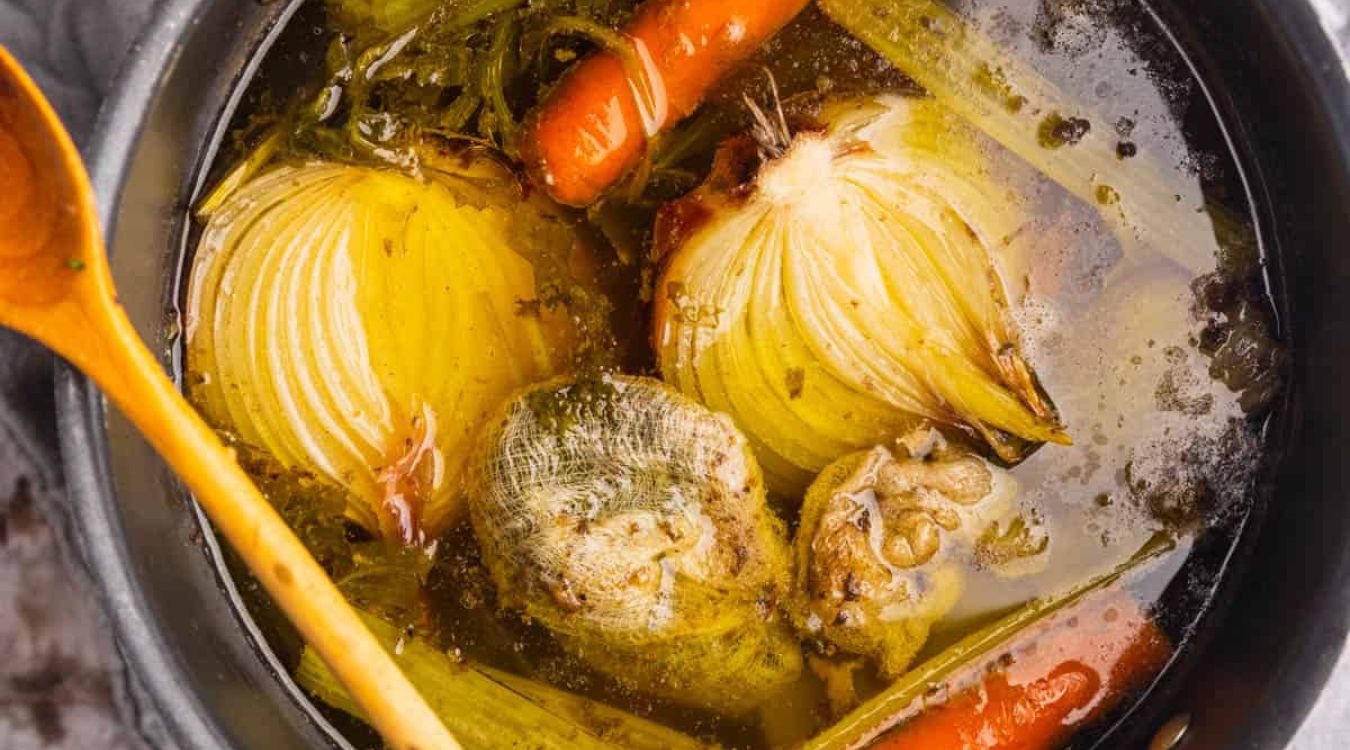A rich and flavorful beef stock is the foundation of many delicious dishes. This basic recipe will guide you through creating a homemade stock that can enhance soups, stews, and sauces. Roasting the beef bones adds depth to the flavor, making it a perfect base for your culinary creations.
While most of the ingredients for this basic beef stock recipe are common, you might need to visit the supermarket for beef bones. These are typically found in the meat section or can be requested from the butcher. Bay leaves and black peppercorns are also essential for adding depth to the stock, so make sure to pick those up if you don't already have them in your pantry.

Ingredients For Basic Beef Stock Recipe
Beef bones: The foundation of the stock, providing rich flavor and nutrients.
Onion: Adds sweetness and depth to the stock.
Carrots: Contributes sweetness and a subtle earthy flavor.
Celery: Adds a fresh, slightly peppery taste.
Garlic: Enhances the overall flavor with its aromatic qualities.
Water: The base liquid for the stock.
Salt: Enhances the flavors of all the ingredients.
Black peppercorns: Adds a mild heat and complexity.
Bay leaves: Imparts a subtle, herbal flavor to the stock.
Technique Tip for Making Beef Stock
For an even richer beef stock, consider adding a tablespoon of tomato paste to the roasted bones before transferring them to the pot. This will enhance the umami flavor and give the stock a deeper color. Additionally, you can also deglaze the baking sheet with a bit of water or red wine to capture all the caramelized bits and add them to the pot for extra depth.
Suggested Side Dishes
Alternative Ingredients
beef bones - Substitute with chicken bones: Chicken bones can provide a rich and flavorful stock, though it will have a lighter taste compared to beef.
beef bones - Substitute with vegetable scraps: For a vegetarian option, use a mix of vegetable scraps like mushroom stems, potato peels, and corn cobs to create a hearty broth.
onion - Substitute with leek: Leeks offer a milder, slightly sweeter flavor that can complement the other ingredients in the stock.
carrots - Substitute with parsnips: Parsnips have a similar texture to carrots but add a slightly sweeter and earthier flavor to the stock.
celery - Substitute with fennel: Fennel provides a subtle anise flavor that can add depth to the stock.
garlic - Substitute with shallots: Shallots offer a milder, more nuanced flavor compared to garlic, which can be a pleasant variation.
water - Substitute with vegetable broth: Using vegetable broth instead of water can add an extra layer of flavor to the stock.
salt - Substitute with soy sauce: Soy sauce can add a savory umami flavor, though it will also darken the color of the stock.
black peppercorns - Substitute with white peppercorns: White peppercorns provide a similar heat but with a slightly different flavor profile that is less pungent.
bay leaves - Substitute with thyme: Thyme offers a different aromatic quality that can still provide a depth of flavor to the stock.
Alternative Recipes Similar to Beef Stock
How to Store or Freeze Your Beef Stock
Allow the beef stock to cool completely before storing. This helps prevent condensation, which can lead to freezer burn or spoilage.
Use airtight containers or heavy-duty freezer bags to store the stock. Make sure to leave some space at the top of the container, as the liquid will expand when frozen.
Label each container with the date and contents. This will help you keep track of how long the stock has been stored and ensure you use the oldest stock first.
For convenience, consider freezing the stock in smaller portions. Ice cube trays or silicone muffin molds work great for this. Once frozen, transfer the cubes to a freezer bag. This allows you to easily use small amounts as needed.
Store the stock in the refrigerator for up to 5 days. If you don't plan to use it within that time, transfer it to the freezer where it can be stored for up to 6 months.
When ready to use, thaw the stock in the refrigerator overnight or use the defrost setting on your microwave. If you're in a hurry, you can also place the container in a bowl of cold water to speed up the thawing process.
Reheat the stock on the stove over medium heat until it reaches a simmer. Avoid boiling, as this can affect the flavor and clarity of the stock.
If you notice any off smells, discoloration, or mold, discard the stock. Always trust your senses to ensure the stock is safe to consume.
How to Reheat Leftovers
Stovetop Method: Pour the beef stock into a saucepan and heat over medium heat. Stir occasionally until it reaches your desired temperature. This method helps maintain the rich flavors and ensures even heating.
Microwave Method: Transfer the beef stock to a microwave-safe bowl. Cover it with a microwave-safe lid or plastic wrap. Heat on high for 1-2 minutes, stirring halfway through. Continue heating in 30-second intervals until hot.
Slow Cooker Method: Pour the beef stock into a slow cooker. Set it to low and let it heat for 1-2 hours. This method is perfect if you want to keep the stock warm for an extended period.
Double Boiler Method: Place the beef stock in a heatproof bowl or pot. Set it over a larger pot of simmering water. Stir occasionally until the stock is heated through. This gentle method prevents scorching and maintains the stock's delicate flavors.
Essential Tools for Making Beef Stock
Oven: Used to roast the beef bones at a high temperature to develop a rich flavor.
Baking sheet: A flat surface to place the beef bones on while roasting in the oven.
Large pot: A big enough vessel to hold all the ingredients and water for simmering the stock.
Knife: Essential for chopping the carrots, celery, and quartering the onion.
Cutting board: A safe surface to chop the vegetables and prepare the garlic.
Fine-mesh strainer: Used to strain the stock and remove the solids, ensuring a clear liquid.
Large bowl: To collect the strained stock after it has been cooked.
Refrigerator: Necessary for cooling the stock and allowing the fat to solidify for easy removal.
Spoon: Useful for skimming off any foam that forms on the surface of the simmering stock.
Tongs: Handy for transferring the roasted bones from the baking sheet to the large pot.
Measuring spoons: To measure out the salt and peppercorns accurately.
How to Save Time on Making Beef Stock
Roast bones in advance: Roast the beef bones ahead of time and store them in the freezer. This way, you can skip the roasting step when you're ready to make the stock.
Use a slow cooker: Instead of simmering on the stove, use a slow cooker to make the beef stock. Set it on low and let it cook overnight.
Pre-chop vegetables: Chop the onion, carrots, and celery in advance and store them in the fridge. This reduces prep time when you start cooking.
Batch cooking: Make a large batch of beef stock and freeze it in portions. This saves time for future recipes.

Basic Beef Stock Recipe
Ingredients
Main Ingredients
- 2 pounds beef bones
- 1 large onion, quartered
- 2 large carrots, chopped
- 2 stalks celery, chopped
- 2 cloves garlic, smashed
- 10 cups water
- 1 teaspoon salt
- 1 teaspoon black peppercorns
- 2 pieces bay leaves
Instructions
- 1. Preheat your oven to 400°F (200°C). Place the beef bones on a baking sheet and roast for 30 minutes.
- 2. Transfer the roasted bones to a large pot. Add the onion, carrots, celery, garlic, water, salt, peppercorns, and bay leaves.
- 3. Bring to a boil, then reduce the heat to low and simmer for 4 hours. Skim off any foam that forms on the surface.
- 4. Strain the stock through a fine-mesh strainer into a large bowl. Discard the solids.
- 5. Let the stock cool, then refrigerate. Once chilled, remove the layer of fat that solidifies on top.
Nutritional Value
Keywords
More Amazing Recipes to Try 🙂
- Vegan Carrot Soup Recipe40 Minutes
- Instant Pot Vegan Tex Mex Bowls Recipe30 Minutes
- Thai Vegan Coconut Curry Recipe45 Minutes
- Vegan Potato Tacos Recipe35 Minutes
- Aperol Spritz Recipe5 Minutes
- Vegan Cilantro Lime Sweet Potato Black Bean Tacos Recipe40 Minutes
- Vegan Lentil Salad with Apples and Carrot Recipe40 Minutes
- Air Fryer Vegan Burger Recipe35 Minutes

Leave a Reply